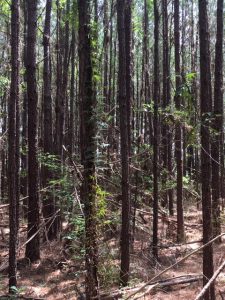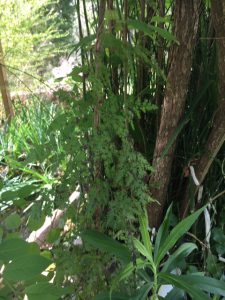As we begin our fourth week of youth science lessons, we will once again look at an invasive species that may be in your yard – not sure. I know a lot of folks have it, but some may not. It is called Japanese Climbing Fern and it can certainly take over if you do not manage it. We will talk about that.

First, let’s get an idea of what it looks like.
As the name suggests, it is a vine that grows up to 90 feet in length. The leaves are “lacy” looking, almost like the snowflakes we use to make with scissors and paper as kids. The leaves are opposite – meaning that the leaf on the right side of the stem of the vine is directly across from the leaf on the left side of the vine. They die back during the winter and appear to be dead – brown and shriveled – and that is how many look right now. This past weekend we found some at the Roy Hyatt Environmental Center. Most were in this “brown-dead” stage but we could see some green leaves coming back. In south Florida, this “brown-dead” stage does not occur, rather the leaves stay green year-round.

These aggressive plants form from thin, wiry black rhizomes (underground stems) that run for some distance in your yard. Their spores form under the leaves of the smaller, younger shoots. These spores are moved around your yard, and to others very easily by the wind – and hence, the plant spreads. It will eventually form dense mats of vines that will completely cover a tree, a fence, your air conditioner unit, just about anything that it can connect to.
As the name implies, it came from Asia and was brought here in the 1930s as an ornamental gardening plant. So, it has the first two of the three needed characteristics of an invasive species- (1) it is nonnative, (2) it was brought by humans. The third needed is that it is causing a problem… and it is. The thick mats of vines formed by this plant quickly cover the native vegetation and impede it from seeding. You would think that covering a fence would not be a problem, but it again is releasing spores and these plants will find native trees and shrubs to cover. Those in the pine timber industry dislike it because it forms such dense mats in their tree plantations that harvesting becomes difficult. A by-product of this industry is pine straw. Landowners will collect this and sell it along with the trees. However, the straw from invested farms is invested with fragments of climbing fern and this is one way it is introduced to your yard – purchasing pine straw for gardening.


So, what do you do about it?
Well, your first thought is to cut it back with clippers, and many people do. However, this does nothing to kill the plant – it will return – but it is a way to control it and keep it from spreading. Pulling it out by hand is the same. There is usually some plant material left and it regrows, but again, it does help control the spread. The active herbicide glyphosate (found in many store herbicide products) does work, but regrowth may appear, and re-treatments may be needed. Some are concerned about using glyphosate. If you have questions about this – ask us, our researchers on campus have been working it for a while and have good information for you.

I have had small patches growing in my yard. Near my garage and by my air conditioning unit. But I am lucky in my case… my dog Burnie likes to eat it. Everyone who has this plant needs a Burnie 😊.
ACTIVITY
Let’s see if we can find any in your yard or neighborhood.
Again, much of it may be brown and look like the vines are dead – probably not. If you do find this keep an eye on it.
We did get some more rain last night, so some new green shoots may be sprouting up as well.
– Do you have it in your yard?
– If so, go onto EDDMapS.com and report it (see Lesson 1 at our website on how to do this – https://blogs.ifas.ufl.edu/escambiaco/category/natural-resources/ ).
– Does it cover a big area?
– If it is not in your yard, is it in an empty lot near you?
– If so, remember you cannot report private property on EDDMapS without property owner’s permission but note this.
I hope everyone made it through the storm last night with no problems. I hope you have a good day and get some outside time.
STAY SAFE.
 0
0
